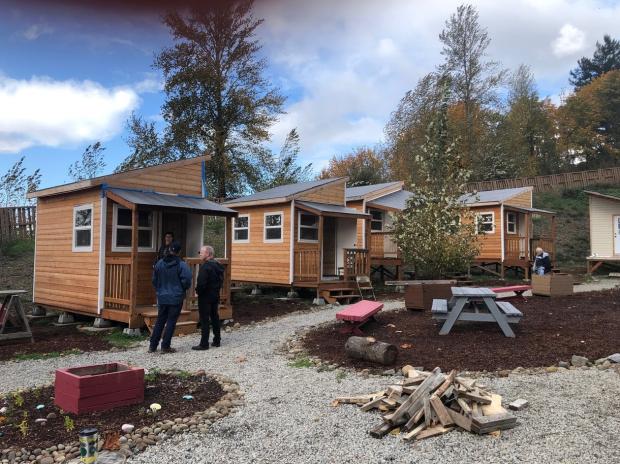Alternative Shelters
A wide range of services are provided in these alternative shelter sites, including on-site case management, physical and mental health services, and housing placement.
What is an alternative shelter?
Alternative shelter is different from ‘traditional’ shelters, which are generally thought of as congregate shelters. When people think of congregate shelters, they imagine large rooms where many people sleep on cots or mats, and where they have to line up night after night to get a bed.
Our congregate shelter system has evolved past that, with rooms divided into more private bays, featuring bunkbeds, and offering kitchens, bathrooms and laundry rooms.
But even with those amenities, some people are unable to cope with the general amount of noise and relative lack of privacy in emergency/congregate shelters.
Alternative shelters are also an alternative to motel sheltering, which is another shelter option that has been made available to families, those with COVID-19 and other vulnerable populations during the pandemic.
The goal for alternative shelters is to provide unique, low-barrier shelter options to serve those who may not feel comfortable accessing other shelter options.

Frequently Asked Questions (FAQs)
How do these fit within the City and County's larger strategy for providing shelter and housing services?
-
These are part of a large network of services funded by the JOHS and the City of Portland. That includes the shelter system detailed above, and housing placement work that helps thousands of people a year leave the streets and shelters for permanent housing.
-
This housing placement work doesn’t rely solely on building new housing; rather it relies on helping people pay rents in market-rate apartments that are already available.
-
Alternative shelter villages provide otherwise unsheltered adults living in PDX with access to essential shelter resources. That has included an emphasis on resources required for staying safe during the COVID-19 pandemic, including proper personal protective equipment, hygiene facilities, education about the virus, testing and vaccine clinics, and the ability to stay physically distant in an outdoor setting. The C3PO villages helped the community maintain and increase shelter capacity during the pandemic, despite the need to space out beds and provide physical distancing.
-
BIPOC Village also emphasizes culturally responsive service provision for BIPOC (Black, Indigenous, People of Color) individuals and households, and the QA Affinity Village supports culturally responsive services for LGBTQIA households. In doing so, the Village supports community members who are underrepresented within shelter systems but over-represented among people experiencing homelessness overall.
-
Participants at any of the alternative shelter villages can access housing and social services throughout the rest of the homelessness response system.
How do the villages ensure safety for the surrounding community?
-
Shelter that focuses on safety and community, while also providing health services and connections to housing resources, is a critical part of local government’s work preventing and ending homelessness. And like any business or program, shelters must be well-run to succeed, not just for their neighbors but for their participants.
-
We hold our operators and programs to high standards, and support them to ensure their success. We have not seen significant issues with crime or other concerns because of our shelters.
-
The JOHS has supported the opening of many shelters since 2016, from the Pearl District to Mill Park. Some sit on commercial strips. Some are next to residences, and near schools and parks.
-
After our shelters have opened, community members have often come together to celebrate and support their new neighbors through activities, volunteering, and donations.
Why are alternative shelter sites like these necessary?
Congregate shelters work well and provide services and stability for many people. But not every unsheltered person is willing or able to live in a congregate shelter environment.
We believe our shelter system should offer a range of models so we offer the best options for as many people as possible. This village model provides individuals experiencing homelessness with shelter, increased safety, and stability.
More Information & Links
-
2024 study by the Homelessness Research and Action Center on the effectiveness of alternative, village-style shelters
-
Analysis: Evaluation and Best Practices for the Village Model (by Portland State University’s Homelessness Research & Action Center)
-
Temporary Outdoor Shelter Program Guide
(Portland Bureau of Development Services)
-
Safe Rest Villages
(City of Portland)



